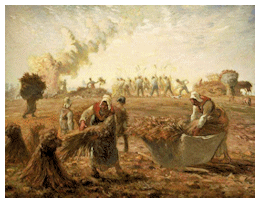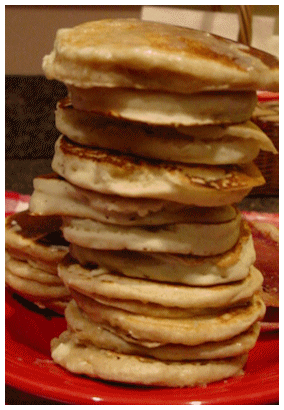buckwheat pancakes

A plant (the Fagopyrum esculentum), of the Polygonum family, the seed of which is used as a grain;– also called brank. Despite its name, buckwheat is not a grain but is grown for its grain-like seeds. — Webster, 1882
 E.A. Morrison, Prop’r, De Smet Roller Mill. Will grind corn, rye, buckwheat, feed, anything in the shape of grain. Sells flour, graham, cornmeal, buckwheat flour, ground feed. – Kingsbury County Independent, 1889
E.A. Morrison, Prop’r, De Smet Roller Mill. Will grind corn, rye, buckwheat, feed, anything in the shape of grain. Sells flour, graham, cornmeal, buckwheat flour, ground feed. – Kingsbury County Independent, 1889
 Buckwheat was grown in Dakota Territory in homesteading days, but grain for flour was mainly grown in Canada at the time. Buckwheat that came in with purchased seed was often mentioned as a nuisance in Dakota newspapers of Laura’s time. An excellent cover crop today, buckwheat grows quickly and can be turned into the soil at flowering for enrichment. Try a patch in your own garden; it has small white flowers, and birds and other animals will love the seeds. It’s easy to grow. “Sow late and cut early” was the emigrant’s rule.
Buckwheat was grown in Dakota Territory in homesteading days, but grain for flour was mainly grown in Canada at the time. Buckwheat that came in with purchased seed was often mentioned as a nuisance in Dakota newspapers of Laura’s time. An excellent cover crop today, buckwheat grows quickly and can be turned into the soil at flowering for enrichment. Try a patch in your own garden; it has small white flowers, and birds and other animals will love the seeds. It’s easy to grow. “Sow late and cut early” was the emigrant’s rule. 
When grown to be harvested, it was cut and bound in sheaves, then “thrashed” (remember the threshing story in Farmer Boy?) and ground into flour. A famous painting showing buckwheat harvest is Jean-Francois Millet’s “Buckwheat Harvest: Summer,” painted in France around the time Laura Ingalls was born, and shown at left. It is housed in Boston’s Museum of Fine Arts.
While Laura Ingalls Wilder writes about pancakes in almost every Little House book (no pancakes in On the Banks of Plum Creek, though), readers most often associate them with Almanzo Wilder, who seems to be able to eat enough pancakes in one sitting to feed a family of four. Mother Wilder cooks ten pancakes at a time in Farmer Boy in what must have been a rather large skillet, and the family eats “pile after pile” of them. In The Long Winter, it’s learned that Almanzo can make even better pancakes than his mother, and he eats at least twenty-one of them in one sitting. He didn’t bother to count the ones he ate while Royal was doing the chores.
Do you know what Mother Wilder’s pancake rule was? In the Little House books, a rule is the same as a receipt, which is the same as a recipe. In my case, I should have remembered the rule not to run get your camera to photograph pancakes while you still have some on the stove, because that batch will surely burn. The fantastic Little House Cookbook (by Barbara Walker, 1979) contains recipes for both buckwheat pancakes (The Long Winter) and pancake men (Little House in the Big Woods), but here’s a recipe for common pancakes, courtesy of Godey’s Lady’s Book and Magazine, September 1874:
Common Pancakes. Make a light batter of three spoonfulls of flour, three eggs well beaten, and half a pint of milk, some of which, with the eggs, is to be mixed with the flour; to the other part, put a quarter of a pound of butter melted. Then mix altogether, and put into the frying-pan in a very thin layer. Fry with lard or dripping; but do not put any butter into the pan to fry them after the first frying, as they will give out enough afterwards to keep up the stock. Sugar should be served to eat with them. Or, when eggs are scarce, make the batter with flour, small beer, ginger, etc. Or, clean snow with flour, and very little milk will serve, but not nearly as well as eggs.
Here’s a recipe for buckwheat cakes from an 1882 issue of the Lake Preston Times. Lake Preston is about seven miles east of De Smet:
Buckwheat cakes. One quart of buckwheat meal, one pint of flour, half a teacupful of yeast; salt to taste, mix the flour, buckwheat and salt with as much water, moderately warm, as will make it into a thin batter. Beat it well, then add the yeast; when well mixed set in a warm place to rise. As soon as they are very light grease the griddle and bake them a delicate brown, butter them with good butter and eat while hot.
Finally, The Female Emigrant’s Guide (C.P. Traill, 1857) includes this recipe for buckwheat pancakes:
Buckwheat pancakes. Take about a quart of finely-sifted buckwheat flour, mix to a batter with warm milk or water, a teaspoon of salt and half a teacup of yeast in water, and leave it in a warm place all night, covered in an earthen pot or tin pail with a cover. In the morning have ready your griddle or frying pan, wiped clean, and some lard or butter, made quite hot. Into this drop a large spoonful or small teacupful of your light batter at a time, until your pan is full, but do not let the cakes touch. If the lard is very hot, the pancakes will set as you pour them in, and be well shaped and light as a honeycomb. Fry a light brown, and turn them, lay them on a hot plate, and serve quite hot, with maple syrup and butter. In place of yeast, the pancakes may be raised by mixing three teaspoonfuls of baking powder just before frying.
A couple of fun pancake trivia bits from the Little House books:
In The Long Winter, Pa is invited to eat pancakes and bacon with Royal and Almanzo. There was molasses on the table and the coffeepot was boiling. In the manuscript, the boys send Pa home with a bottle of molasses. Awwwwww!!
In Little House on the Prairie, Laura and Mary wake up to the smell of bacon and coffee and they hear pancakes sizzling. In the manuscript, it’s that they could smell bacon and coffee and see Ma frying pancakes. In one version of the manuscript, they could see her frying them in the spider over some coals.
I listened hard, and I couldn’t hear much sizzling coming from my pancakes.

buckwheat cakes / pancakes (FB 3; TLW 10; PG), see also pancake

